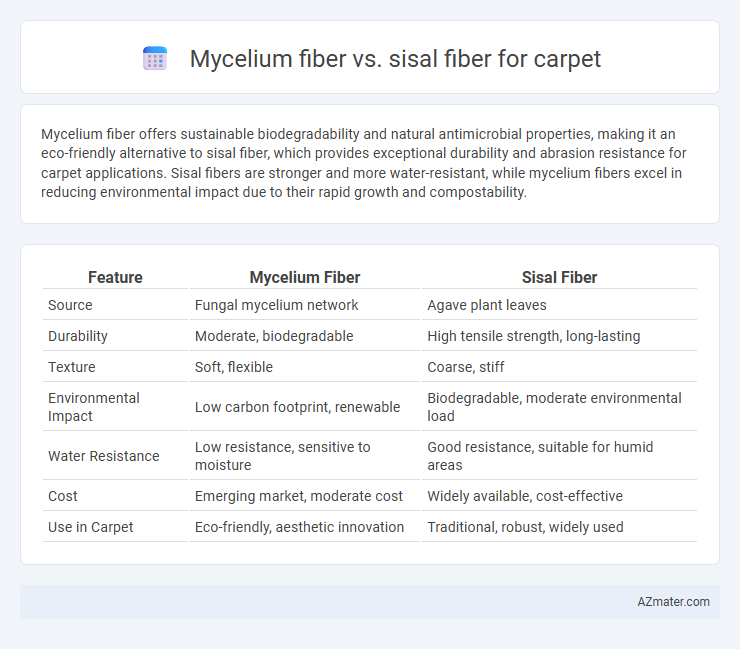Mycelium fiber offers sustainable biodegradability and natural antimicrobial properties, making it an eco-friendly alternative to sisal fiber, which provides exceptional durability and abrasion resistance for carpet applications. Sisal fibers are stronger and more water-resistant, while mycelium fibers excel in reducing environmental impact due to their rapid growth and compostability.
Table of Comparison
| Feature | Mycelium Fiber | Sisal Fiber |
|---|---|---|
| Source | Fungal mycelium network | Agave plant leaves |
| Durability | Moderate, biodegradable | High tensile strength, long-lasting |
| Texture | Soft, flexible | Coarse, stiff |
| Environmental Impact | Low carbon footprint, renewable | Biodegradable, moderate environmental load |
| Water Resistance | Low resistance, sensitive to moisture | Good resistance, suitable for humid areas |
| Cost | Emerging market, moderate cost | Widely available, cost-effective |
| Use in Carpet | Eco-friendly, aesthetic innovation | Traditional, robust, widely used |
Introduction to Mycelium and Sisal Fibers
Mycelium fiber, derived from the root structure of fungi, offers a sustainable and biodegradable alternative for carpet materials, known for its lightweight and flexibility. Sisal fiber, extracted from the Agave sisalana plant, provides exceptional durability and natural resistance to stains and wear, making it a popular choice for high-traffic areas. Both fibers represent eco-friendly options, with mycelium emphasizing innovative fungal biomaterials and sisal highlighting traditional plant-based strength in carpet applications.
Origins and Production Processes
Mycelium fiber, derived from fungal root structures, originates from sustainable fungal cultivation using agricultural waste, enabling a low-energy, biodegradable production process. Sisal fiber, sourced from the Agave sisalana plant native to Mexico and Brazil, involves harvesting and decorticating the leaves through water retting or mechanical extraction to obtain coarse, durable fibers. While mycelium fiber production emphasizes eco-friendly biotechnological methods, sisal fiber relies on traditional agricultural and mechanical labor-intensive processing.
Physical Properties Comparison
Mycelium fiber exhibits superior tensile strength and flexibility compared to sisal fiber, making it more resilient under heavy foot traffic in carpet applications. Sisal fiber offers excellent abrasion resistance and natural stiffness, contributing to durability but less softness underfoot. Both fibers provide good moisture-wicking properties, though mycelium fibers have a finer microstructure that enhances breathability and reduces odor retention in carpets.
Environmental Impact and Sustainability
Mycelium fiber, derived from fungal root structures, offers a biodegradable and rapidly renewable alternative to traditional sisal fiber, which is sourced from agave plants requiring extensive land and water resources. Mycelium production generates minimal agricultural waste and absorbs carbon dioxide, enhancing its sustainability profile compared to sisal's more resource-intensive cultivation and processing. Both fibers contribute to eco-friendly carpet manufacturing, but mycelium's lower environmental impact and faster growth cycle position it as a more sustainable option for green flooring solutions.
Durability and Lifespan
Mycelium fiber offers superior durability compared to sisal fiber due to its enhanced tensile strength and resistance to wear, making it ideal for high-traffic carpet areas. Sisal fiber, while strong, tends to degrade faster under heavy use and is more prone to fraying and discoloration over time. The lifespan of mycelium fiber carpets generally exceeds that of sisal carpets, providing longer-lasting performance and reduced maintenance costs.
Comfort and Aesthetic Qualities
Mycelium fiber offers a unique softness and natural elasticity that enhances carpet comfort, making it more cushiony underfoot compared to sisal fiber, which is typically coarser and rougher. Aesthetically, mycelium carpets exhibit a smooth, uniform texture with earthy tones that create a modern, organic look, whereas sisal fibers provide a distinct, rugged appearance with natural variations that evoke a rustic, traditional style. Both fibers are sustainable choices, but mycelium's innovative cultivation process allows for customizable colors and patterns, offering greater design versatility in carpet applications.
Cost Analysis and Market Availability
Mycelium fiber offers a sustainable and innovative alternative to sisal fiber but currently incurs higher production costs due to limited large-scale manufacturing facilities, resulting in a higher price point in carpet applications. Sisal fiber remains more cost-effective and widely available in the market, sourced primarily from established suppliers in East Africa and Brazil, supporting economies of scale in carpet production. Market availability favors sisal fiber for mainstream use, while mycelium fiber is gaining niche demand in eco-conscious and premium carpet segments despite its present cost challenges.
Maintenance and Cleaning Considerations
Mycelium fiber carpets require minimal maintenance due to their natural resistance to stains and odors, making them ideal for high-traffic areas. Sisal fiber carpets demand more frequent vacuuming and prompt spot cleaning as they are prone to moisture damage and staining. Both materials benefit from gentle, non-abrasive cleaning methods, but sisal's susceptibility to mildew necessitates careful moisture control during maintenance.
Applications in Modern Carpet Manufacturing
Mycelium fiber offers innovative sustainability benefits in modern carpet manufacturing due to its biodegradable and renewable nature, making it ideal for eco-conscious designs. Sisal fiber, derived from the Agave plant, provides durability and natural resistance to wear, widely used in high-traffic areas and commercial carpets. Combining mycelium's environmental advantages with sisal's robustness enables manufacturers to create eco-friendly carpets that maintain longevity and aesthetic quality.
Future Prospects and Industry Trends
Mycelium fiber is gaining traction as a sustainable alternative to sisal fiber for carpet manufacturing, driven by growing eco-conscious consumer demand and advancements in biotechnology enabling scalable production. Sisal fiber remains dominant due to its durability and established supply chains, yet its environmental impact faces scrutiny compared to mycelium's biodegradability and lower resource requirements. Industry trends indicate a shift towards hybrid carpets combining mycelium and sisal fibers to balance performance with ecological benefits, highlighting innovation in bio-based materials for floor coverings.

Infographic: Mycelium fiber vs Sisal fiber for Carpet
 azmater.com
azmater.com